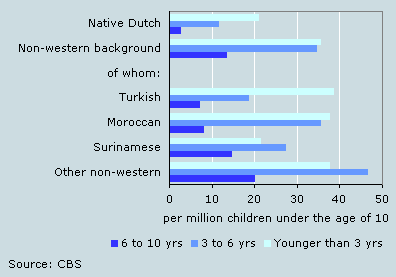Recently immigrated children more often drown

The drowning rate is higher among children from non-western countries who recently immigrated to the Netherlands than among native Dutch children. Children in the age group 6–10 are relatively often drowned.
Reduced risk of drowning
Since the mid-1990s, the risk of drowning for children has been reduced. Only for children with a non-western background who recently immigrated to the Netherlands run a higher risk. Their risk of drowning is three times as high as for native Dutch children.
Drowning accidents, 1996/2005

Immigrants run highest risk
Nowadays, about 20 children under the age 10 annually die in drowning accidents. Two thirds are boys. Among 2 to 4-year-old boys, drowning is the most important single category of death causes. The risk of drowning for young children has dropped in recent years, but has risen among immigrant children. The risk for children of Somali, Iraqi, Iranian or Afghan descent is three times as high as for children with a native Dutch background. In the period 1996–2005, altogether 41 children belonging to the above ethnic categories were drowned on a total of 266 children who died in fatal drowning accidents in this period.
Drowned children by age, 1996/2005

6 to 10-year-old children with non-western background often involved in drowning accidents
Approximately half of young children who drown are under the age of three. The risk of drowning for native Dutch children drops dramatically with advancing age. Among children with a non-western background, on the other hand, slightly older children relatively often drown. The risk of drowning for 6 to 10-year-old non-western children is about five times as high as for native Dutch children. Prevention indeed appears to be a more successful strategy for curbing the risk of drowning in the case of children with a non-western background than in the case of native Dutch children.
Joop Garssen and Jan Hoogenboezem